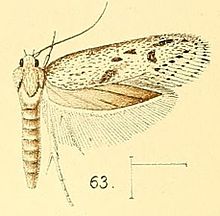Holcocera is a gelechoid moth genus of the family Blastobasidae. There are about 70 described species.[2]
| Holcocera | |
|---|---|

| |
| Holcocera irroratella | |
| Scientific classification | |
| Domain: | Eukaryota |
| Kingdom: | Animalia |
| Phylum: | Arthropoda |
| Class: | Insecta |
| Order: | Lepidoptera |
| Family: | Blastobasidae |
| Subfamily: | Holcocerinae |
| Genus: | Holcocera Clemens, 1863[1] |
| Species | |
|
Several, see text | |
| Synonyms | |
| |
Taxonomy
editThe genera Hypatopa and Calosima are sometimes treated as synonyms of Holcocera.
Species
edit- Holcocera aclydis
- Holcocera adjutrix Meyrick, 1918
- Holcocera amicae
- Holcocera amicitiae
- Holcocera anomalella
- Holcocera arcae
- Holcocera audaciae
- Holcocera aurorae
- Holcocera basiplagata Walsingham, 1912
- Holcocera bucinae
- Holcocera calthae
- Holcocera cathedrae
- Holcocera cerradicola
- Holcocera chalcofrontella
- Holcocera chloropeda Meyrick, 1922
- Holcocera coccivorella
- Holcocera concolor
- Holcocera crassicornella
- Holcocera cryptae
- Holcocera cylindrota Meyrick, 1918
- Holcocera digesta Meyrick, 1922
- Holcocera dominae
- Holcocera epitomae
- Holcocera eusaris Meyrick, 1922
- Holcocera extensa
- Holcocera famae
- Holcocera fergusoni Adamski, 2004
- Holcocera fugae
- Holcocera gargantuella
- Holcocera gigantella
- Holcocera gozmanyi Adamski & Landry, 2007
- Holcocera grenadensis
- Holcocera guilandinae
- Holcocera hemiteles Walsingham, 1912
- Holcocera homochromatica Walsingham, 1912
- Holcocera ianuae
- Holcocera iceryaeella
- Holcocera immaculella
- Holcocera increta Meyrick, 1930
- Holcocera irroratella
- Holcocera iubae
- Holcocera laudis
- Holcocera lignyodes
- Holcocera limicola Meyrick, 1922
- Holcocera luxuriae
- Holcocera lyrae
- Holcocera macrotoma Meyrick, 1916
- Holcocera mortis
- Holcocera musicae
- Holcocera nephalia Walsingham, 1912
- Holcocera notae
- Holcocera nuptae
- Holcocera panurgella
- Holcocera paradoxa
- Holcocera percnoscia Meyrick, 1932
- Holcocera piratae
- Holcocera plagatola
- Holcocera poetae
- Holcocera portae
- Holcocera puellae
- Holcocera pugionaria Meyrick, 1918
- Holcocera sakura Ohshima, 2003
- Holcocera sollertiae
- Holcocera subolivacea (Walsingham, 1897)
- Holcocera sympasta Meyrick, 1918
- Holcocera titanica Walsingham, 1912
- Holcocera villella
- Holcocera zonae
Former species
edit- Holcocera anthracographa Meyrick, 1937
- Holcocera aphanes (Zeller, 1877)
- Holcocera controversella (Zeller, 1877)
- Holcocera orthophrontis Meyrick, 1932
- Holcocera proagorella (Zeller, 1877)
- Holcocera suppletella (Zeller, 1877)
References
edit- Adamski, D., 2000: A new North American Calosima (Lepidoptera: Coleophoridae: Blastobasinae). Tropical Lepidoptera Research 11 (1-2): 46-48.
- Adamski, D., 2002: Blastobasinae (Lepidoptera: Gelechioidea: Coleophoridae) of Thailand, Part 1. Four new species of Calosima Dietz, 1910. Insecta Koreana 19 (3-4): 233-239.
- Adamski, D. & M. Hoddle, 2009, A new Holcocera Clemens from Guatemala and redescription of H. iceryaeella (Riley) from the United States (Lepidoptera: Coleophoridae: Blastobasinae: Holcocerini): Two congeners with incidental preference for avocado, Proc. Entomol. Soc. Wash. 111 (1): 254-262.
- Adamski, D. & R.W. Hodges, 1996: An annotated list of North American Blastobasinae (Lepidoptera: Gelechioidea: Coleophoridae). Proceedings of the Entomological Society of Washington 98 (4): 708-740.
- Adamski, D. & C.T. Maier, 2003: A new Holcocera Clemens (Lepidoptera: Gelechioidea: Coleophoridae: Holcocerini) associated with Pinaceae in North America. Proceedings of the Entomological Society of Washington 105 (1): 144-148.
- Adamski, D. ; R.S. Copeland ; S.E. Miller ; P.D.N. Hebert ; K. Darrow & Q. Luke, 2010: A review of African Blastobasinae (Lepidoptera: Gelechioidea: Coleophoridae), with new taxa reared from native fruits in Kenya. Smithsonian contributions to Zoology 630: 1-68. Full article: [1].